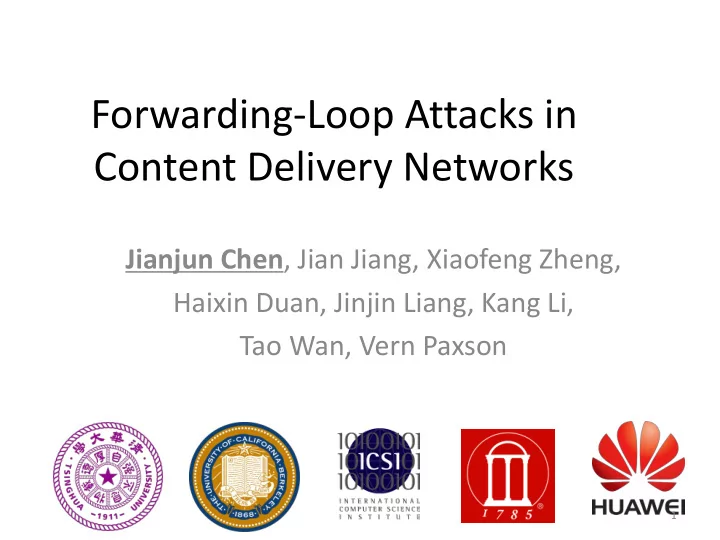

Forwarding-Loop Attacks in Content Delivery Networks Jianjun Chen , Jian Jiang, Xiaofeng Zheng, Haixin Duan, Jinjin Liang, Kang Li, Tao Wan, Vern Paxson 1
Content Delivery Networks • CDN is now an important Internet infrastructure, it is a popular solutions for: – Performance, Security(WAF), Availability(anti-DDoS) CDN has its own architectural weaknesses Client CD Website N Attacker 2
Our work • We present “forwarding loop” attacks that threaten CDN availability. • We measured 16 popular CDNs and find all of them are vulnerable to such attacks. • Vendors have acknowledged the problem and are actively addressing it. 3
The normal forwarding process of CDNs Normal example.com -> D CDN customer POST / POST / Host: example.com Host: example.com Client Website D CDN A Customer controls forwarding rules of CDNs 4
Conceptual view of a forwarding-loop attack Attacker (Malicious customer) example.com -> B POST / Host: example.com Attacker POST POST CDN A example.com -> C example.com -> A POST CDN B CDN C • Malicious customers can manipulate forwarding rules to create loop 5 • Amplification -> consume resource -> potentially DoS
Practicality of forwarding-loop attacks • Cost – All 16 CDNs provide free or free-trial account • Anonymity – 11/16 CDNs only require an email address • Some CDNs agreed this attack is severe • Next we describe 3 types of looping attacks, and 3 factors for enhancing the loop – Self loop, intra-CDN, Inter-CDN – Abort-forwarding, Streaming, gzip bomb 6
Self loop Configuration Entry example.com -> IP of A/loopback POST Affected vendors(1/16): • Azure(China) Attacker CDN A Loop in a single node 7
Intra-CDN loop Configuration Entry example.com -> attack.com POST Affected vendors(7/16): CDN A 1 CDN A • Azure(China) • CDN77 Attacker IP of A2 • CDNlion POST POST • CDN.net Authority DNS ns.attack.com • CDNsun IP of A1 • KeyCDN IP of A3 • MaxCDN CDN A 3 CDN A 2 POST Loop among multiple nodes within one CDN 8
Loop Detection by CDNs example.com -> attack.com POST / Host:example.com CDN A 1 POST / Attacker Host:example.com IP of A2 Header: Loop-Detection-Tag Authority DNS ns.attack.com CDN A 2 CDN A 3 Current Defenses Use headers to tag processed requests Attacker countermeasure Extends forwarding loops across multiple CDNs 9
Loop-Detection Headers are different CDN Provider Loop Detection CDN Provider Loop Detection Header Header Akamai Akamai-Origin-Hop CloudFlare X-Forwarded-For CF-Connecting-IP Alibaba Via CloudFront Via Azure(China) Fastly Fastly-FF Baidu X-Forwarded-For Incapsula Incap-Proxy-ID CF-Connecting-IP CDN77 KeyCDN CDNlion Level3 Via CDN.net MaxCDN CDNsun Tencent X-Daa-Tunnel RFC 7230 recommends to use Via header for loop detection 10
Bypassing CDN defenses • Chain loop-aware CDNs to other CDNs that can be abused to disrupt loop-detection headers • Abusive features provided by CDNs: CDN Provider Reset Filter CDN77 Via CDNlion Via CDN.net Via CDNsun Via Fastly No-self-defined MaxCDN Any 11
Inter-CDN loops: POST / Host: example.com POST / Attacker POST / Host: example.com Host: example.com Via: 1.1 abcd (CloudFront) CloudFront Via: 1.1 abcd (CloudFront) Akamai-Origin-Hop:1 Akamai Filter rules: 1.Remove Via POST / 2.Remove Akamai-Origin-Hop Host: example.com MaxCDN Via: 1.1 abcd(CloudFront) Akamai-Origin-Hop:1 12
Can a loop last indefinitely ? • Limitation on header size might terminates a loop – All CDNs limit header size; – some CDNs increase header size when forwarding a request; – Filtering and reset behaviors can bypass such limitation • Timeout might also terminate a loop – A careful attacking plan can avoid this effect. 13
Handling timeout Factors Attacker countermeasure Timeout Add a no-abort-forwarding node(7/16) Timeout Timeout A A C B B Continues C No-abort-forwarding Abort-forwarding • Experiment – A request loops for 5+ hours among CloudFlare, MaxCDN, CDN77 and our control node 14
How to enlarge attacking traffic? • Streaming loop – faster speed -> overlap -> higher traffic – All nodes need to support streaming – 7/16 CDNs support request streaming, all CDNs support response streaming 15
“Dam F looding” attack: streaming loop with response example.com -> attack.com POST POST CDN A Attacker Attacker’s website D IP of D IP of B Authority DNS ns.attack.com example.com -> A example.com -> C CDN C CDN B 16
Enhance streaming loop with gzip bomb POST / Host:example.com Accept-Encoding:identity example.com -> attack.com CDN A Attacker Unzip Gzip bomb Attacker’s website Authority DNS ns.attack.com CDN C CDN B example.com -> A example.com -> C • 3 CDNs can be used to uncompress gzip bombs • Total Amplification Factor = Loop Amplification * Gzip Bomb Amplification(~ 1000) 17
Defenses • Unifying and standardizing a loop-detection header, – Via as recommended by RFC • Interim defenses, independently – Obfuscating self-defined loop-detection headers – Monitoring and rate-limiting – Constraint on forwarding destination 18
CDN Vendor Feedback • CDNs are actively addressing it – CloudFlare and Baidu implemented Via header – CDN77 and CDNsun will change to not reset Via – Verizon (Edgecast) agreed the problem is serious – Tencent evaluates as high risk – Fastly actively discussed defenses with us – Alibaba are intreseted in interim defenses 19
Summary • A variety of implementation issues make forwarding loops a potentially severe attack vector • A case that highlights the danger of allowing cross-organization, user-controlled (untrusted) policies without centralized administration • How to enforce standard compliance, especially when global coordination is needed 20
Acknowledgement 21
Thank you! 22
Recommend
More recommend